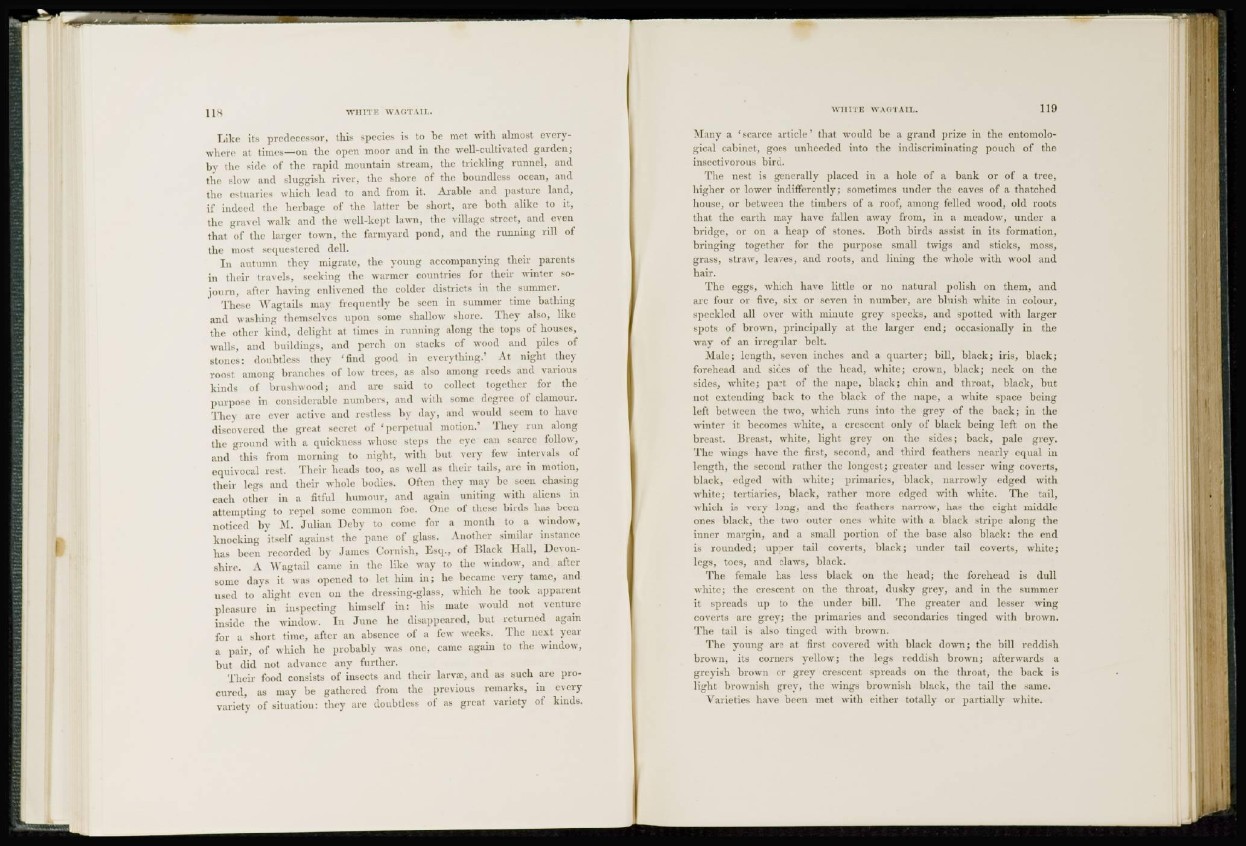
Like its predecessor, this species is to be met with almost everywhere
at times—on the open moor and in the well-cultivated garden;
by the side of the rapid mountain stream, the trickling runnel, and
the slow mid sluggish river, the shore of the boundless ocean, and
the estuaries which lead to and from it. -Arable and pasture land,
if indeed the herbage of the latter be short, are both alike to it,
the gravel walk and the well-kept lawn, the village street, and even
that of the larger town, the farmyard pond, and the running rill of
the most sequestered dell.
In autumn they migrate, the young accompanying their parents
in their travels, seeking the warmer countries for their winter sojourn,
after having enlivened the colder districts in the summer.
These \\ agtails may frequently be seen in summer time bathing
and washing themselves upon some shallow shore. They also, like
the other kind, delight at times in running along the tops of houses,
walls, and buildings, and perch on stacks of wood and piles of
stones: doubtless they 'find good in everything.' At night they
roost among branches of low trees, as also among reeds and various
kinds of brushwood; and are said to collect together for the
purpose in considerable numbers, and with some degree of clamour.
They arc ever active and restless by day, and would seem to have
discovered the great secret of • perpetual motion.' They run along
the ground with a quickness whose steps the eye can scarce follow,
and this from morning to night, with but very few intervals of
equivocal rest. Their heads too, as well as their tails, are in motion,
their legs and their whole bodies. Often they may be seen chasing
each other in a fitful humour, and again uniting with aliens in
attempting to repel some common foe. One of these birds has been
noticed by M. Julian Deby to come for a month to a window,
knocking itself against the pane of glass. Another similar instance
has been recorded In James Cornish, Esq., of Black Hall, Devonshire.
A Wagtail came in the like way to the window, and after
some days it was opened to let him in; he became very tame, and
used to alight even on the dressing-glass, which he took apparent
pleasure in inspecting himself in: his mate would not venture
inside the window. In June he disappeared, but returned again
for a short time, after an absence of a few weeks. The next year
a pair, of which he probably was one, came again to the window,
but did not advance any further.
Their food consists of insects and their larva;, and as such are procured,
as may be gathered from the previous remarks, in every
variety of situation: they arc doubtless of as great variety of kinds.
Many a 'scarce article' that would be a grand prize in the entomological
cabinet, goes unheeded into the indiscriminating pouch of the
insectivorous bird.
The nest is generally placed in a hole of a bank or of a tree,
higher or lower indifferently; sometimes under the eaves of a thatched
house, or between the timbers of a roof, among felled wood, old roots
that the earth may have fallen away from, in a meadow, under a
bridge, or on a heap of stones. Both birds assist in its formation,
bringing together for the purpose small twigs and sticks, moss,
grass, straw, leaves, and roots, and lining the whole with wool and
hair.
The eggs, which have little or no natural polish on them, and
are four or five, six or seven in number, are bluish white in colour,
speckled all over with minute grey specks, and spotted with larger
spots of brown, principally at the larger end; occasionally in the
way of an irregular belt.
Male; length, seven inches and a quarter; bill, black; iris, black;
forehead and sides of the head, white; crown, black; neck on the
sides, white; part, of the nape, black; chin and throat, black, but
not extending back to the black of the nape, a white space being
left between the two, which runs into the grey of the back; in the
winter it becomes white, a crescent only of black being left on the
breast. Breast, white, light grey on the sides; back, pale grey.
The wings have the first, second, and third feathers nearly equal in
length, the second rather the longest; greater and lesser wing coverts,
black, edged with white; primaries, black, narrowly edged with
white; tertiaries, black, rather more edged with white. The tail,
which is very long, and the feathers narrow, has the eight middle
ones black, the two outer ones white with a black stripe along the
inner margin, and a small portion of the base also black: the end
is rounded; upper tail coverts, black; under tail coverts, white;
legs, toes, and claws, black.
The female has less black on the head; the forehead is dull
wdrite; the crescent on the throat, dusky grey, and in the summer
it spreads up to the under bill. The greater and lesser wing
coverts arc grey; the primaries and secondaries tinged with brown.
The tail is also tinged with brown.
The young are at first covered with black down; the bill reddish
brown, its corners yellow; the legs reddish brown; afterwards a
greyish brown or grey crescent spreads on the throat, the back is
light brownish grey, the wings brownish black, the tail the same.
Varieties have been met with either totally or partially white.